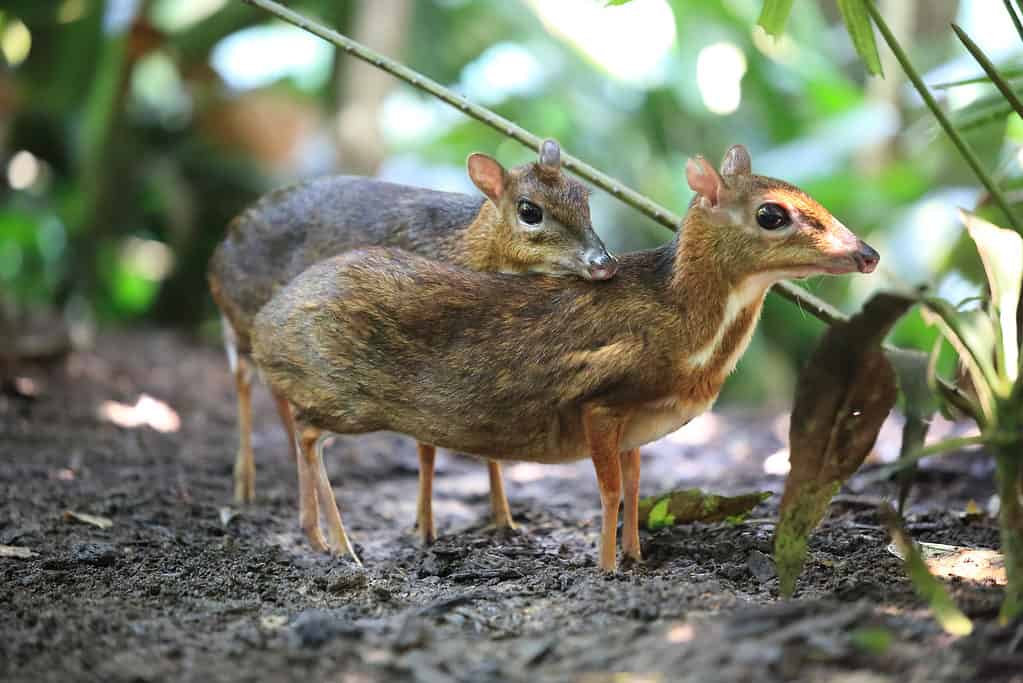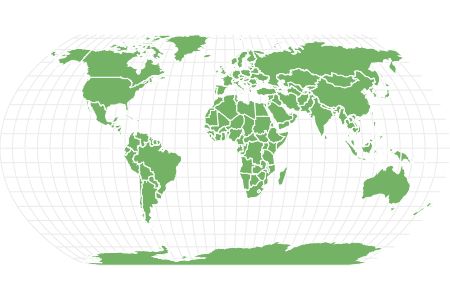Mouse-Deer (Chevrotain)
Tragulidae
The mouse deer is neither a species of mouse nor deer, but instead part of its own unique family of hoofed animals. It is the smallest hoofed animal.
Advertisement
Mouse-Deer (Chevrotain) Scientific Classification
- Kingdom
- Animalia
- Phylum
- Chordata
- Class
- Mammalia
- Order
- Artiodactyla
- Family
- Tragulidae
- Genus
- Tragulus
- Scientific Name
- Tragulidae
Read our Complete Guide to Classification of Animals.
Mouse-Deer (Chevrotain) Conservation Status
Mouse-Deer (Chevrotain) Facts
- Prey
- sometimes insects
- Name Of Young
- fawn
- Group Behavior
- Solitary
- Fun Fact
- The mouse deer is neither a species of mouse nor deer, but instead part of its own unique family of hoofed animals. It is the smallest hoofed animal.
- Biggest Threat
- Human activity and deforestation
- Most Distinctive Feature
- Long thin legs
- Other Name(s)
- Chevrotain
- Gestation Period
- 6 months
- Age Of Independence
- 3-4 months
- Litter Size
- 1
- Habitat
- dense wet forests
- Predators
- Big cats, birds of prey, dogs, humans, reptiles
- Diet
- Herbivore
- Lifestyle
- Nocturnal
- Special Features
- hoofs
- Slogan
- Tiny hooved creature that looks like a cross between a mouse and a miniature deer
Mouse-Deer (Chevrotain) Physical Characteristics
- Color
- Brown
- Red
- Black
- Orange
- Skin Type
- Fur
- Lifespan
- up to 10 years
- Weight
- 4-11 pounds
- Height
- 13 inches
- Length
- 29 inches
- Age of Sexual Maturity
- Is the mouse-deer monogamous?
- Age of Weaning
- 2 weeks months
View all of the Mouse-Deer (Chevrotain) images!
The mouse-deer (also called the chevrotain) is a small, nocturnal mammal found in Southeast Asia’s forests. They are shy and elusive animals, and very little is known about them. It is the smallest hoofed mammal in the world, and it gets its name from its resemblance to mice and deer. They have a reddish-brown coat and are usually about the size of a rabbit. Mouse-deer are herbivores and eat leaves, fruits, and insects. Tigers, leopards, snakes, and birds of prey are their predators. They are solitary creatures, and they only come together to mate. Females give birth to one or two young at a time.
5 Incredible Mouse-Deer Facts
- The chevrotain is the smallest hoofed mammal in the world.
- They are is nocturnal, meaning it is most active at night.
- The Java mouse-deer has a pair of large tusks that protrude from its lower jaw. They use these tusks for defense and digging roots, and as tubers to eat.
- They are excellent jumpers and may leap into the air when frightened.
- They live in tropical forests in Southeast Asia, where they feed on leaves, fruits, and insects.
Scientific Name
The scientific name for the chevrotain is Tragulidae. Tragulidae is a family of small ungulates in tropical areas of Africa, Asia, and southern Europe. The family consists of four genera and eight species. That being said, the mouse-deer is the only non-extinct member of this family. They get their name from their small size and resemblance to mice and deer. They are shy animals that are primarily active at night.
Appearance

Mouse-deer have pointed snouts, with small, protrusive ears.
©YAMASA/Shutterstock.com
The mouse-deer is a small unique mammal that lives in tropical forests. Their small size, short legs, hoofed feet, and long tail characterize them. They are generally brown or reddish, with white spots on their backs and sides, and resemble miniature deer. The animal has a pointed snout with small ears that protrude up on the sides of its head. They also have abnormally long, thin legs with hoofs.
Evolution
This little creature is thought to have first appeared on Earth around 34 million years ago, and since then, has undergone many changes to adapt to its environment. The most notable change in the chevrotain’s evolution is its size; over time, these animals have shrunken in size significantly. This is likely because they are prey animals, and their smaller size makes it harder for predators to spot them. Additionally, their diet has changed somewhat over time; while the animal in the past is thought to have primarily eaten vegetation and plants, they now almost exclusively eat fallen fruit. Early members of the species had much longer tails than their modern counterparts. This adaptation likely helps them balance easier. It’s evident that the mouse-deer has undergone several changes in its anatomy and physiology over time.
Behavior
The mouse-deer is a timid creature that humans seldom see. When startled, they often run away quickly and hide in the vegetation around them. Although they are not typically fast runners, their ability to zigzag through the forest makes them challenging to catch. Loud noises and sudden movements easily scare them. Also, they are very shy and will usually flee if they sees a larger animal nearby. However, if you are patient and quiet, you may be able to get close enough to see it up close.
Habitat
The mouse-deer’s natural habitat is dense, moist forest vegetation. However, due to deforestation and habitat loss, they have been forced to adapt to living in more open habitats, such as secondary forests and even urban areas. Mouse-deer are the most active at night when they search for food in the forest understory. During the day, they rest in dense vegetation to avoid predators.
Diet
The mouse-deer’s diet consists mainly of fruits, but if fruit is scarce, it will also eat plants, insects, snails, and small vertebrates when required. They can extract nutrients from plants that other animals cannot digest. They are generally solitary creatures, but they will come together during the mating season or when there is a plentiful food source.
What Eats the Mouse-Deer?
The main predators of the mouse-deer are crocodiles, large birds of prey, tigers, other big cats, and dogs.
What Does the Mouse-Deer Eat?
Mouse-deer mainly eat fruits, vegetables, grasses, and in some rare cases, insects.
Predators and Threats
Due to their small size and timid nature, the mouse-deer are easy prey for predators, including tigers, leopards, snakes, and birds of prey. Some more common predators of the chevrotain include wild cats. These animals will often stalk and ambush their prey, making it difficult for the mouse-deer to escape. In addition to natural predators, humans also threaten the mouse-deer. Hunting and habitat loss are two of the biggest threats to this species. Hunters may target the mouse-deer for its meat, which some cultures consider a delicacy.
Habitat loss is the foremost threat that mouse-deer face, as the mouse-deer’s natural habitats are being destroyed by deforestation and other human activities. The mouse-deer is a fascinating creature that is, unfortunately, facing many threats and could become extinct if serious conservation action is not taken.
Reproduction
Because mouse-deer are shy and elusive creatures, studying them is challenging. However, we know they reproduce year-round, with peak breeding seasons occurring during the wet months. Female mouse-deer (chevrotains) usually give birth to a single offspring, though twins have been known to occur. The gestation period is around six months long. After giving birth, mothers will care for their young until they are old enough to fend for themselves, which is typically around three to four months old.
Mouse-Deer Babies
Baby mouse-deer are called fawns. As you now know, mouse-deer are tiny animals, and their offspring are even smaller. Because of this, they are often preyed upon by larger animals. To protect their young, mouse-deer mothers often carry them in their mouths. However, even with this protection, many young mouse-deer do not survive to adulthood. This is because they are so small and vulnerable that they are often killed before they have a chance to grow up. Despite the challenges young mouse-deer face, some manage to reach adulthood. These adult mouse-deer can then have offspring, continuing the life cycle and helping their population numbers.
Lifespan
The average lifespan of a mouse-deer is around ten years, but in captivity, the species only live for around 6 years. Some threats to the mouse-deer include, but are not limited to:
- Predators
- Diseases
- Habitat loss
- Other human activity
Mouse-Deer Population
The population numbers for the mouse-deer have been declining in recent times. They are believed to be declining due to habitat loss, predation, and hunting pressure. Although, there are many reasons why chevrotain populations have declined so dramatically.
Hunting is a significant threat to all mouse-deer species, as they are hunted for their meat or tusks, which may be used in traditional medicine. Habitat loss is also a significant problem, as they require forests with dense understory vegetation to thrive. As more and more forests are cleared for agriculture or other development projects, they lose the habitats they need to survive as a side effect.
The decline of mouse-deer populations is a serious conservation concern, as these animals play an essential role in their ecosystems. For example, they help disperse seeds and control insect populations. If mouse-deer disappear entirely from the wild, it could have devastating consequences for many other species that depend on them.
Related Animals…
View all 164 animals that start with MMouse-Deer (Chevrotain) FAQs (Frequently Asked Questions)
Are mouse-deer carnivores, herbivores, or omnivores?
The mouse-deer is primarily an herbivore, but in some rare cases, it feeds on insects.
Is the mouse-deer monogamous?
The mouse-deer can be monogamous when breeding or raising offspring.
Which countries are the mouse-deer found in?
The mouse-deer is mainly found in Asia. It is prominent in countries like Malaysia, Indonesia, Sri Lanka, Thailand, and Vietnam.
What is the average lifespan of a mouse-deer?
The average lifespan of the mouse-deer in the wild is approximately 10 years.
Thank you for reading! Have some feedback for us? Contact the AZ Animals editorial team.
Sources
- Britannica, Available here: https://www.britannica.com/animal/chevrotain
- Treehugger, Available here: https://www.treehugger.com/chevrotain-small-secretive-mouse-deer-4864353

















